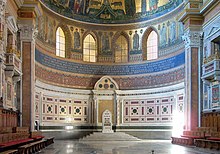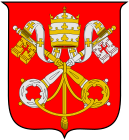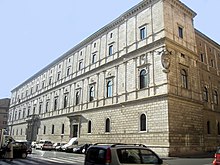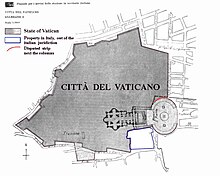Holy See
The Holy See (in Latin, Sancta Sedes) —also known as the Apostolic See, Sede of Peter or See of Rome, among other variants— is the seat of the Bishop of Rome, the pope, which occupies a pre-eminent place among the other episcopal sees, constitutes the central government of the Catholic Church, for whom he acts and speaks, and is recognized internationally as a sovereign entity. his responsibility at the head of the Catholic Church.
The Pope uses the Curia and processes ecclesial affairs through it, so it carries out its work in the name and under the authority of the Supreme Pontiff, for the proper functioning of the Church and the achievement of its objectives. The Roman Curia is made up of a group of institutions, among which are the Secretary of State, departments, justice agencies and economic agencies, and other offices.
The Roman Curia has the function of assisting the pope in his government of the universal Church and of the particular Churches; It does not, however, have a specific pastoral mission for the diocese of Rome, so for the spiritual needs of the diocese there is the Vicariate of Rome, opposite which is the Cardinal Vicar, who governs the Italian territory of said diocese with vicarious power of the supreme pontiff. For the specific territory of Vatican City, within the same diocese, there is another vicariate headed by a vicar general.
The legal personality of the Holy See allows it to maintain diplomatic relations with other states, sign treaties, and send and receive diplomatic representatives, something that goes back several centuries. Since the end of the 15th century, it began to receive diplomatic envoys with some stability, and in the 16th century permanent representations began to be set up. Currently, it also participates in international organizations such as the United Nations.
The Holy See has full ownership and exclusive sovereignty over Vatican City, a State established in 1929, after the signing of the Lateran Pacts, with the aim of being an instrument of the independence of the Holy See and of the Catholic Church with respect to any other external power. Abstractly, in addition to being the Holy See the supreme government and representation of the Church, it is also the supreme government of Vatican City. Other territories outside of Vatican City also have extraterritorial status in favor of the Holy See.
Origin of the term
The term Holy See or Apostolic See as an allusion to the pope and his authority has its origin in the consideration of the bishop of Rome as the successor of Saint Peter and visible head of church.
In early Christian times local churches that had been founded by one of the apostles were referred to as "apostolic sees" but over time this term was reserved for the bishop of Rome, as successor to the head of the Apostolic College.
Aside from Rome, only the German bishopric of Mainz (Mainz) can use the designation Holy See today in the Western Church, calling itself Holy See of Mainz > or, in Latin, sancta sedes moguntia.
The Apostolic See in Catholic doctrine
Note the different orientation and superposition of the keys that indicate what emblem it is about: that of the Holy See presents the golden key in the band and above that of silver in the bar, tied with gold cord; instead that of the Vatican City shows the silver key in the band and above that of gold in the bar, tied with cloaks. Both shields present the papal tiara with the sparkling between the keys. The absence of papal tiara characterizes the emblem of the Holy See in vacant headquarters times, replaced by the conopeo or umbraculum.
Catholic doctrine predicates a series of attributes of the pope, which are the supremacy and fullness of the powers of the regime (legislative, executive and judicial powers) and of the magisterium.
On the one hand, this implies the supremacy of the pope's power in all matters related to the government and discipline of the Church, a power that is also full and immediate and that he can exercise over all pastors and all the faithful.
Thus, the jurisdiction of the Holy See as such was established in the following terms:
The Roman Pontiff, the successor of Saint Peter in the primacy, not only has the primacy of honor, but also the supreme power of jurisdiction over the universal church, as well as in things concerning faith and morals, and in those matters which belong to the discipline and rule of the Church spread throughout the world. This power is truly episcopal, in an ordinary and immediate way, over every one of the churches, over every one of the pastors and the faithful, independent of any human authority.
On the other, it means that the teaching function of the Church acquires a special aspect in the person of the Roman Pontiff, since his ordinary magisterium enjoys special consideration and since he is the only person who individually enjoys the privilege of infallibility, that is, when he defines a certain doctrine on Faith or Morality as revealed by God, he is preserved from error.
Roman Curia
The Roman curia is the set of governing bodies of the Holy See. The Pope uses and processes the affairs of the Church through it, so the Curia carries out its work in the name and under the authority of the Supreme Pontiff, for the proper functioning of the Church and the achievement of its objectives. made up of a group of institutions, among which are the Secretary of State, departments, justice agencies and economic agencies, and other offices.
The Roman curia has the function of assisting the pope in his government of the universal Church and of the particular churches; It does not have a specific pastoral mission for the diocese of Rome, so for the spiritual needs of said diocese there is the Vicariate of Rome, in front of which is the Cardinal Vicar, who governs the Roman diocese with the vicarious power of the Supreme Pontiff. For the specific territory of Vatican City, within the diocese, there is also a vicariate headed by the Vicar General of Vatican City.
Secretary of State
The Secretariat of State is the department that collaborates most closely with the Supreme Pontiff in the exercise of his functions. Its origins date back to the XV, and has had various configurations during its history. It is currently divided into three sections: the Section for General Affairs (or First Section), the Section for Relations with States (or Second Section) and the Section for the Diplomatic Staff of the Holy See (or Third Section).
The first section is in charge of the pope's usual affairs, from the drafting of documents or the procedures for appointments in the Curia to the activity of his representatives in private churches, embassies before the Holy See or the communication. The second section, on the other hand, is in charge of relations with civil governments, the signing of concordats or similar with the States and the representation of the Holy See in international organizations. The third section deals with issues related to the personnel of the diplomatic service of the Holy See.
The Secretary of State is headed by a Cardinal Secretary of State, who since the end of 2013 has been Pietro Parolin. The Secretary of State is the highest exponent of both diplomatic and political activity of the Holy See, and may even represent the Pope himself.
Courts
The pope is the supreme judge of the Catholic Church, and can pass sentence personally, delegating to judges or through the ordinary courts of the Holy See. There are three courts: the Apostolic Penitentiary, which is responsible for issues related to the internal forum and indulgences, that is, the forgiveness of sins; the Apostolic Signature, which acts as the supreme court; and finally the Roman Rota, the court of appeal before the pope.
Status in international law
The Holy See has been recognized, both in state practice (international relations) and modern legal doctrine as a subject of international law, with rights and obligations analogous to those of States. Although the Holy See, unlike Vatican City, does not meet all the criteria established in international law for statehood (a permanent population, a defined territory, a stable government, and the ability to enter into relations with other States), the full possession of legal personality in international law is demonstrated by the fact that it maintains diplomatic relations with 180 States and that it is a member of several international organizations.
Diplomatic relations
Since the Middle Ages the episcopal seat of Rome has been recognized as a sovereign entity. The Holy See maintains diplomatic relations with 180 sovereign states, in addition to the European Union and the Order of Malta; it also maintains special relations with the Palestine Liberation Organization. 69 of the diplomatic missions accredited to the Holy See are in Rome.
The Holy See maintains 180 permanent diplomatic missions abroad, of which 74 are non-residents, therefore several of its 106 missions are accredited to two or more countries or international organizations, thus constituting one of the largest diplomatic networks around the world. The diplomatic activities of the Holy See are directed by the Secretariat of State (headed by the Cardinal Secretary of State), through the Section for Relations with States. There are 15 internationally recognized states with which the Holy See does not maintain relations.
The Holy See is a member of several international organizations and other groups, such as the International Atomic Energy Agency (IAEA), the Organization for Security and Cooperation in Europe (OSCE), and the United Nations High Commissioner for Refugees (UNHCR). The Holy See is also a permanent observer member in several international organizations, including the United Nations, the Council of Europe, UNESCO, the World Trade Organization (WTO), the World Health Organization (WHO) and the Food and Agriculture Organization. and Agriculture (FAO).
Diplomatic representatives of the Holy See, with the rank of ambassador, are called nuncios (apostolic nuncio or papal nuncio).
Territorial sovereignty
Throughout history, popes have had power over different territories. Since the institution of the Holy See, the faithful donated goods and territories that would become part of papal domains. In the XVIII century The popes controlled the central strip of the Italian peninsula, as well as enclaves such as Avignon and Venassino, in France, and Pontecorvo and Benevento, in Naples. Currently, the territory under the sovereignty of the Holy See is reduced to Vatican City, an enclave of just 0.44 km² in the city of Rome; however, its jurisdiction also applies to some areas of Italy with extraterritorial rights, in addition to the nunciatures spread throughout the world.
Vatican City
The Papal States, over which the pope had ruled until 1870, had been absorbed by the Kingdom of Italy in the process of Italian unification and, as a consequence, the pope and the Holy See had been subject to sovereignty Italian for all practical purposes, creating an environment of hostility between the Catholic Church and the Italian State, a situation called the "Roman question".
The Holy See believed that it was not possible to carry out its mission without the independence of the political powers that temporal power gave it. Due to the impossibility of restoring the old papal territories annexed by the Kingdom of Italy or that the pontifical seat was transferred to another location, the solution to the Roman question was the creation of a State under papal power reduced to the minimum territorial expression.
The Lateran Pacts, signed on February 11, 1929 by Cardinal Secretary of State Pietro Gasparri, on behalf of Pope Pius XI, and by Italian Prime Minister Benito Mussolini, on behalf of King Victor Emmanuel III, They implied the political independence of the Holy See from the Kingdom of Italy, through the creation of the Vatican City State, as well as the full restoration of relations between the representatives of Italy and the Catholic Church, broken since 1870.
In these agreements, the Kingdom of Italy first recognized the sovereignty of the Holy See in the international field "as an attribute inherent to its nature, in accordance with its tradition and the demands of its mission in the world", admitting it "full ownership, and the exclusive and absolute power and sovereign jurisdiction" over the territory of Vatican City, which "supposes that there is no interference on the part of the Italian Government and that there is no other authority than the that of the Holy See". The consequence of the pacts for the papacy was a gain in both moral authority and political independence for the free exercise of its pastoral activity.
Although Vatican City is a sovereign State, it does not possess all the usual characteristics of a political community. It is an atypical State with an instrumental function, which "exists for the convenient guarantee of the exercise of freedom of the Apostolic See, that is, as a means to ensure its real and visible independence in its governmental activity in favor of the universal Church, as well as its pastoral work aimed at the entire human race; It does not have its own society for which it has been constituted, nor is it even based on the forms of social action that ordinarily determine the structure and organization of any other State. In addition, the people who collaborate with the Apostolic See, or even cooperate in the government within the Vatican City State, are not, with few exceptions, citizens of it, nor, consequently, do they have the rights and obligations (in particularly tax) that ordinarily arise from belonging to a State".
Vatican City's form of government is absolute monarchy, with the pope being the head of state, who holds full executive, legislative, and judicial powers. Legislative power is exercised by the Pontifical Commission for the Vatican City State; The executive power is exercised by the president of the Governatorato and the directorates and central offices in which the Governatorato is organized depend on him. Finally, the judicial power is exercised in the name of the Supreme Pontiff by a single judge, a court of first instance, a court of appeals and a court of cassation.
In Vatican City is the Apostolic Palace, the official residence of the pope. Pope Francis decided, however, after his election, that his habitual residence would be in the Domus Sanctae Marthae, using the palace for audiences and receptions for authorities and for the usual Sunday Angelus prayer. The main religious building in the territory is the Basilica of San Pedro, built on the tomb of the apostle considered by the Catholic Church as the first pope.
Contenido relacionado
Saint Andrew
Theodosius II
British Virgin Islands










